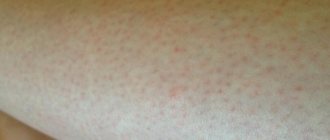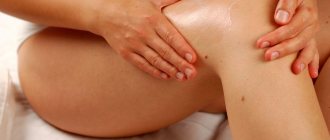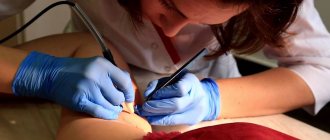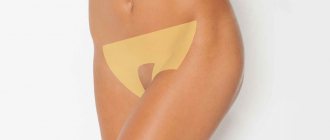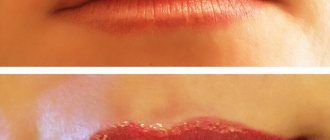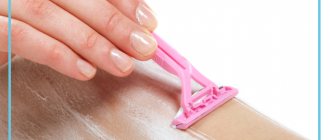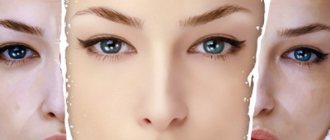Waxing today is one of the most popular ways to combat the growth of unwanted hair. This method is quite effective, however, many people, especially those with sensitive skin, often experience irritation on the skin after such procedures.
In this article we will look at the possible causes of this side effect and tell you how to relieve irritation after waxing.
First signs of irritation after waxing
Irritation after waxing may appear a few minutes after the procedure, or it may make itself felt after a few hours or even the next day. This depends on the degree of skin sensitivity, the level of stress received by the body during depilation, and actions after the session.
The first sign that indicates irritation is a burning sensation or slight tingling sensation in the treated area , which intensifies over time. These symptoms appear before you even see obvious signs of a problem.
The second essential sign of irritation after waxing –
redness of the skin.
It can appear as a single spot, but most often small red dots are formed, abundantly scattered over the treated surface . Redness is accompanied by itching, which often reaches such a degree that you want to scratch the skin. Advice ! Try not to scratch the skin, much less scratch it. Such actions can lead to the formation of wounds, which then take a long time to heal, and even worse, to the penetration of infection into the body through wounds .
A little later, in place of the red dots, pustules with a white core may form. People with hypersensitive skin may experience a local increase in body temperature and mild chills.
How to properly carry out hair removal itself so that there is no irritation and red spots?
To obtain an effective result from hair removal, the procedure should be carried out following special rules:
- Carefully choose the epilation method, study in detail the instructions for using special attachments.
- If the procedure is being carried out for the first time, you need to start it from the area with the least vegetation.
- Surface treatment should take place in stages, with short pauses.
- Always start removing vegetation at low speed, and only after the skin gets used to it, proceed to increase the speed.
- The nozzle must be held at a vertical angle if the legs are being treated, and rotated in a circular motion when the epilator is applied to the armpits and groin area.
- During the procedure, the skin should be slightly stretched in the direction opposite to the head of the device.
- After all manipulations, an antibacterial moisturizer must be applied to the areas affected by the epilator.
These simple rules will help not only minimize all kinds of complications, but also relieve unpleasant pain.
Important!
If you carry out the procedure in the evening, the red dots after the epilator will disappear during sleep.
Main reasons
There are many reasons for irritation after waxing. The most common ones include:
- low quality wax;
- incorrect implementation of the procedure, violation of the instructions for using the product;
- sensitive skin;
- allergy to wax or auxiliary elements of hair removal products;
- the presence of damage to the treated area of the skin (scratches, wounds);
- recent depilation of the treated area with a razor or epilator;
- contact after the procedure of the treated skin area with synthetic materials;
- applying foundation or creams or other products that contain alcohol to the treated skin.
To reduce the risk of skin irritation, it is necessary to carry out the procedure correctly. If you are not doing this in a salon, we recommend that you familiarize yourself with the material - how to do waxing at home.
Thus, the appearance of irritation can be caused not only by the procedure itself or the hair removal product, but also by a violation of safety rules after the session. It is necessary to strictly follow the instructions for handling wax when epilating; the slightest deviation can lead to unpleasant consequences. Information . Many cosmetologists believe that after waxing, irritation is the body’s natural reaction to the resulting stress. It is believed that the first procedure in almost 95% will lead to skin irritation , which may not occur after subsequent sessions. People with very fair skin are especially susceptible to this reaction after waxing.
Possible consequences
Let's start with how hair removal is done at home. This is a procedure for mechanical removal of body hair along with hair follicles. That is, hair is simply pulled out of the skin (sugaring, waxing and epilator). Naturally, the skin necessarily reacts to such a process, and in different ways.
Among the possible consequences and complications, four main ones can be named:
- feet itch
- irritation occurs;
- after hair removal, ingrown hairs appear on the legs;
- Pigmentation changes (age spots).
Of course, modern techniques used in salons - photoepilation, laser hair removal, etc. - are today considered more gentle and painless. They provide anti-inflammatory or soothing dermatological treatments.
Now we will talk about the process of hair removal at home, which can be done in different ways:
- using an electric epilator;
- using wax strips;
- using tweezers;
- thread;
- sugar (sugaring), etc.
We’ll also talk about what to lubricate your legs after hair removal.
Did you know? In Russia, they began to epilate the skin with wax or resin, following the example of Princess Olga.
Irritation
Irritation is the number one complication of the procedure; almost everyone experiences it. Redness occurs at the site of any damage. This is skin irritation.
After hair removal, irritation on the legs is often accompanied by itching, redness, and then peeling (as a consequence of the inflammatory process after the wounds heal).
Itching
Itching after the procedure appears along with irritation. If you calm the skin a little, the inflammation will go away, but the itching may remain for a long time.
Itching can also appear as an allergic reaction to products used for hair removal: wax, gelatin, sugar, etc.
Ingrown hair
If itching and irritation can be dealt with in 1-2 days, then ingrown hairs are a more serious complication after hair removal, the consequences of which can be pigment spots on the legs.
When mechanically removing hairs, the structure of the hair follicle and skin layer is disrupted, and the hair begins to grow at a different angle. Changing the angle of hair growth leads to the fact that it tries to grow in a new place, which means it tries to pass through the dense layer of the epidermis “in a different way.” If germination fails, the hair bends and grows in the opposite direction, without finding a way out. Such ingrown hair is fraught with inflammation and even suppuration.
First, red bumps appear, the legs become red after hair removal. Then these tubercles become inflamed, sometimes a hair appears through a thin layer of skin. If it does not come out for a long time, the inflammation intensifies and pus appears. In this way, the body fights the unwanted process.
Dark spots
After several sessions of mechanical hair removal, red or brown pigment spots may appear. This often happens because the skin becomes rough.
Pigment spots appear where there was inflammation, irritation, or ingrown hairs. More spots may appear when the skin is not sufficiently moisturized after procedures.
A completely logical question arises: how to remove dark spots between the legs. Pharmacy and folk whitening products will help here.
It is recommended to use badyagi powder and hydrogen peroxide as a mask for areas with altered pigmentation. The mask is applied for 20-30 minutes 2 times a week.
If the spots have not gone away within a month, contact a dermatologist or a trusted beauty salon.
How to remove irritation after waxing
If you have decided to have waxing for the first time, you should definitely think in advance about how to get rid of irritation after waxing.
At the same time, no one is protected from the possibility of such a side effect suddenly appearing, even if everything went well before. At home, you should always have at least some remedy in your arsenal for such a case. The sooner measures are taken to save the skin, the faster and less painful the symptoms will pass. Important ! Action to eliminate irritation must be taken immediately. Delaying is fraught with inflammation of the skin, the formation of wounds, which will then take a long time to get rid of.
Pharmacy products (oils, creams, ointments, etc.)
Pharmacies have a large variety of remedies for skin irritation in their arsenal. When choosing a specific drug, be sure to pay attention to its composition - it should not contain alcohol-containing components, as well as elements to which you may be allergic.
An inexpensive and effective remedy for skin irritation is “Rescuer” ointment. When the first signs of damage to the skin appear, you can wipe the skin with hydrogen peroxide.
For minor irritation, a moisturizing baby cream will cope well with the ailment. The following tools have also proven themselves well in this area:
- post-depilation gel “Aloe vera and arnica” from Green Mama;
- BelKosmex anti-irritation cream;
- cream-gel after depilation Velvet;
- Cicactive gel from Uriage;
- Klorane post-hair removal cream.
These products have a calming effect on the skin, moisturize it well, and have an antibacterial and wound-healing effect.
They can also be used after treatments to prevent the side effects of waxing. Cicactive gel is especially recommended in case of irritation after waxing on the face. Klorane cream, in addition to its pronounced softening, moisturizing and soothing effect, slows down the growth of unwanted hair when used regularly.
This is confirmed in many reviews of the product. If wounds have formed during irritation, or you have scratched them, it will not hurt to treat the damaged surface with furatsilin, chlorhexidine or miramistin.
But what to do if severe irritation appears after depilation? In such cases, it is recommended to use ointments for burns or products that contain panthenol. These include Depanthenol, Bepanten.
Folk remedies
If the irritation is not too severe, you can try using folk remedies. Among them, the most popular are the following:
- If there is irritation on the face after waxing, wipe the skin with ice;
- wipe the affected area with aloe juice or pulp;
- treat the damaged area with a mixture of one part tea tree oil and four parts of any other vegetable oil;
- wipe the skin with a decoction of equal parts of chamomile and chamomile (half a tablespoon per 150 ml of water, add hot water and leave for 15 minutes in a steam bath);
- wipe the damaged area with calendula decoction (dessert spoon with 150 ml of water, add hot water and leave for 15 minutes in a steam bath);
- treat irritated skin with baby powder.
Important ! You cannot use several products at the same time. It is also not recommended to rinse the skin with water.
How to treat the skin after the procedure?
In order for irritation to go away as quickly as possible and not progress, immediately after facial hair removal you must:
- Cool and soothe the skin with an ice pack. You can simply apply it to the epilated area for literally a minute.
- Disinfect the skin with the same Chlorhexidine. The more expensive Miramistin can also be used for this purpose. You should not use alcohol solutions, as they can only aggravate irritation on delicate skin.
- Do not use oils, lotions or baby powder. If such compounds get into the pores of epilated skin, they can cause inflammation.
- Do not wet epilated skin for at least eight to twelve hours.
Treatment of the skin with antiseptics and cold compresses can be repeated several times. Usually only this is enough for the skin to more or less calm down by morning.
Preventing irritation
In order to prevent irritation, you need to follow several important rules:
- do not take a bath or shower for the first few hours after the session;
- on the day after the procedure, do not use hard washcloths or scrubs;
- on the day after the session, do not sunbathe, do not swim in bodies of water, including the sea;
- if depilation of the pubic area was carried out, it is advisable to exclude sexual contact on the first day;
- When depilating your armpits, you should avoid using deodorants on the day of the procedure;
- When depilating your face on the day of the session, you cannot use foundation, alcohol-containing tonics, or creams.
This video presents methods for relieving irritation after depilation, as well as tips for skin care before and after this procedure.
As a preventive measure after a wax procedure, it is recommended to treat the skin with a post-wax depilation product . This could be a rich moisturizer or baby cream. Also getting good reviews:
- ItalWax post-depilation lotion;
- Delica cooling gel after intimate depilation;
- tea tree oil mixed with several parts of another vegetable oil.
It is advisable to use products that contain extracts of chamomile, thyme, calendula or aloe. To prevent irritation, it is recommended to steam the skin well before the procedure.
Is it possible to completely avoid the appearance of red dots after using an epilator and how to do this?
To prevent red dots from becoming a disastrous result of hair removal, there are subtleties in treating individual zones that you need to know.
Bikini area
Before you start using the epilator, you need to prepare the groin area with massage rollers and reduce the pain threshold with a freezing aerosol. After removing the hair, you need to thoroughly treat the area with an antiseptic, moisturize and nourish with a proven cosmetic product.
Armpit area
Before using an epilator, cut off too long hairs with scissors, and rinse the entire skin fold thoroughly using hygiene products and dry. After manipulation, disinfect the skin and apply a cold compress.
Legs
Preparation for the procedure should begin in advance by scrubbing and steaming the skin. Immediately before manipulation, you need to disinfect and dry it. Then carefully remove hairs from the outer thighs, under the knees and ankles. Then, gently stretching the skin, treat the entire surface. Finish the procedure with a light, non-greasy moisturizer.
Hair removal without red spots and irritation is possible if:
- Observe hygiene rules.
- Avoid touching your skin with towels, synthetic fabrics, tight or tight-fitting items for several hours.
- Do not expose treated areas to sunlight, do not steam them, and do not use cosmetics with active ingredients.
- Temporarily stop visiting the solarium, sauna and swimming pool.
How to soothe the skin and remove redness?
If red dots and spots still appear on your face after hair removal, you need to deal with them in a more directed manner. A good find for this might be:
- Actovegin gel. This is a pharmaceutical drug that perfectly stimulates and accelerates the healing process. It should be applied in a thin layer to problem areas several times a day. Solcoseryl gel also has a similar composition and properties.
- Panthenol. This is a cream product based on dexpanthenol (one of the forms of vitamin B5). It is believed that this medicine, when applied to the skin, effectively moisturizes, stimulates regeneration processes and promotes the rapid disappearance of skin defects. Panthenol can be used twice or thrice a day.
- Chamomile or calendula decoction. Such herbs have good anti-inflammatory and soothing qualities. They can be brewed according to the instructions on the package and used to prepare lotions for problem areas.
- Witch hazel. This is a natural-based ointment that copes well with irritations caused by poor circulation. It should be used twice a day.
- Fresh aloe juice. To treat irritation, you can keep an aloe leaf in the refrigerator, then cut it and wipe the problem area with the pulp. You can also extract juice from such a plant and use it to make lotions.
- Miramistin. This effective antiseptic can be used for regular treatment of skin affected by depilation.
- Antihistamines. Allergy medications will help relieve redness and make the irritation less noticeable. You should not take them constantly - one tablet will be enough.
If pustules appear on the skin, it is better not to risk it and seek advice from a dermatologist. After all, such a phenomenon may indicate the addition of a secondary infection.
Complications of various types of hair removal
| shaving | wax | threads | sugaring | electro | photo | A.F.T. | laser | |
| irritation | ++++ | +++ | ++++ | ++ | ++++ | — | — | — |
| crusts | ++ | ++ | ++ | + | ++++ | ++ | + | — |
| ingrown hairs | ++++ | +++ | +++ | — | — | — | — | — |
| scars | — | + | + | + | +++ | + | — | — |
| burns | — | +++ | — | + | — | ++ | + | — |
| hypo- and hyperpigmentation | — | ++ | — | +++ | ++ | + | + | — |
| edema | — | + | + | — | +++ | + | + | — |
| frequency of procedures | 1 Week | 2 weeks | 2 weeks | 2 weeks | Once every 4-5 years* | Once a year* | Once a year* | Once a year* |
* - supporting procedures necessary after completing a one-time course
Author of the material: Dermatologist, cosmetologist N.M. Lachinova. All rights reserved.
How to prevent
It is almost impossible to prevent red spots and dots from appearing on your legs after hair removal, but you can reduce their number. Tips from hair removal experts will help you do this:
- About a day before, cleanse the skin of your feet with a scrub. It will remove dead cells and thereby “open” the path to the hair root. But it’s better not to overdo it, since the scrub itself causes microtrauma to the skin, and hair removal will only intensify them.
- Disinfect the skin. At a minimum, wash your feet with soap, or better yet, wipe them with Miramistin, Chlorhexidine or any alcohol-based lotion.
- Pre-steam the skin of your feet. A warm bath will make further hair removal easier and improve the hair removal process, but not all cosmetologists praise this method.
- In contrast to the previous method, it is recommended to cool the skin of the feet. It is believed that this will help dull the transmission of nerve impulses, reduce pain and prevent the appearance of red spots and dots.
- Grow hairs to the desired length. They should not be too short or too long, otherwise irritation and the appearance of red spots and spots on the legs will not be avoided.
- Refuse to visit the sauna or steam bath 3 days before the procedure, avoid any caring procedures such as wraps, massage.
Folk remedies
If you don’t find any of the proposed options in your medicine cabinet, you can turn to traditional medicine recipes. Spots and red dots on the legs after hair removal are eliminated by the following remedies:
- Aloe vera juice. It is necessary to squeeze the juice from this plant and lubricate your feet with it. If somewhere the damage and irritation is too strong, there are a lot of red spots and dots, you can make a compress from a leaf of this succulent, cut lengthwise or ground into a paste.
- Infusion of medicinal plants. All you need to do is brew the herbal mixture as tea or boil it for a couple of minutes. Filter this infusion and then use it to wipe your legs after hair removal. Chamomile, yarrow, celandine, oak bark, and linden flowers have a good healing, anti-inflammatory, and calming effect.
- Vegetable oil. It is rich in polyunsaturated fatty acids, which soften, restore, and nourish skin covered with red spots and dots. If there are wounds on your feet, you can add tea tree essential extract to the oil.
Medications
Pharmacy antiseptics can relieve irritation, relieve pain and minimize discomfort after the procedure:
- Miramistin. It has an active antimicrobial and antifungal effect, destroying various pathogens on the surface of the skin of the feet. Miramistin prevents infection of wounds and accelerates their healing.
- Bepanten. A remedy well known to young mothers. With the help of Bepanten, it is customary to treat diaper rash in children. But this drug has many useful properties. It eliminates peeling, cracks, and fights the feeling of tightness that often appears after hair removal along with red dots and spots.
- D-Panthenol. A substance such as dexpanthenol can often be found in creams and milks for the body, hands, and face. Dexpanthenol belongs to the B vitamins. It is involved in various metabolic processes, improves skin regeneration, normalizes cellular metabolism, and increases the strength of collagen fibers.

